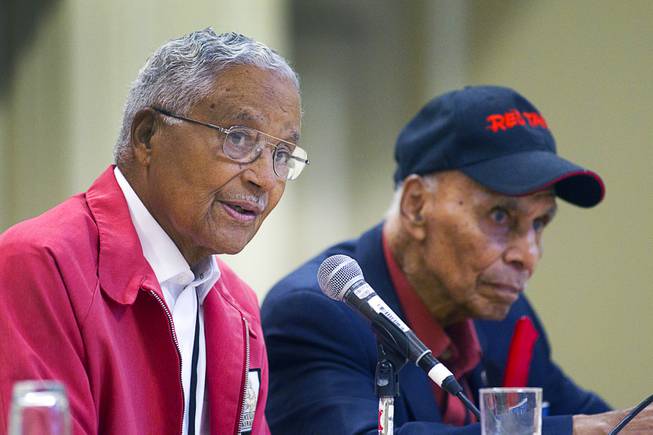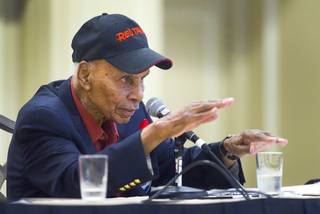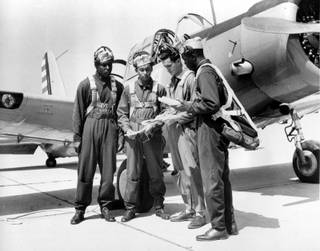
Tuskegee Airmen Charles E. McGee, left, and Roscoe C. Brown, Jr. participate in a panel discussion during the International Black Aerospace Council convention at the Las Vegas Hotel Wednesday, August 1, 2012. McGee holds an Air Force record of 409 fighter combat missions flown in World War II, Korea and Vietnam.
Thursday, Aug. 2, 2012 | 2 a.m.
Capt. Roscoe Brown spent two years flying with the famed Tuskegee Airmen during World War II, logging more than 200 missions with his squadron. But, Brown says, people only ever ask about one.
“Everybody always wants to know how I shot down the jet,” the 90-year-old Brown said Wednesday in Las Vegas.
Brown, then 23 years old, was flying a long-range mission in 1945 as an escort for bombers on their way to attack Berlin when he saw a fleet of jets on his 11 o’clock. After some slick maneuvering, including a “reverse reel” in which he turned the plane upside down to better position himself, Brown shot one of the new, highly advanced German Me-262 fighter jets, becoming the first pilot in history to down a jet in combat while flying a conventional aircraft.
Brown, who went on to earn a doctorate at New York University after the war, recounted that story and a host of others during a panel discussion Wednesday afternoon as part of the International Black Aerospace Council convention at LVH — Las Vegas Hotel.
Sharing the stage with fellow Tuskegee Airman Col. Charles McGee, the two fielded questions from an audience of about 100 people, discussing everything from aerial tactics to airplane engineering and the racial climate they encountered as part of the first group of black aviators to serve in the military.
Famed for breaking down racial barriers in the military as well as for their flying prowess, the Tuskegee Airmen comprise a group of nearly 1,000 pilots trained at the Tuskegee Army Air Field in Alabama. About half of those pilots served overseas during World War II, flying more than 300 missions and developing a reputation for their protection of bombers during escort missions.
The airmen’s legacy lives on through the nonprofit Tuskegee Airmen Inc., which works to honor the original airmen’s history while encouraging young people’s interest in aviation and science.
Larry Jackson, a captain of flight operations with Southwest Airlines who helped organize Wednesday’s panel, said the event, which was recorded, was aimed at capturing the history of the Tuskegee Airmen while the original members were still around to tell it.
“I don’t care what color you are or what sex you are, we’re all standing on the shoulders of the Tuskegee Airmen,” he said. “They knocked down doors that are now open to all of us ... and a lot of what they did they did in spite of the adversity they faced.”
The story of the Tuskegee Airmen was recently retold in the 2012 George Lucas film “Red Tails,” which was a popular nickname for the airmen owing to the painted tailfins of their planes, but Brown said many of the details of the true story were changed in the Hollywood retelling.
“One of the things you learn about Hollywood is you can’t shoot a movie as a newsreel,” said Brown, who consulted on the film. “Some of the details weren’t completely accurate, but the reason for that was poetic license and a need to get the film done. ... It didn’t show as much of the racism as we actually encountered.”
Brown said the Tuskegee Airmen were doubted because of their race and as a result felt extra pressure to perform.
“We were an experiment. We had to be better,” he said. “It was a challenge to be better than the rest.”
Air Force Tech. Sgt. John Wells, who is based out of New Jersey, said like many black airmen, he’s deeply interested in the history of the Tuskegee Airmen and that Wednesday was an opportunity for him to experience that history firsthand.
“In my mind, anyone breaking racial barriers and being able to achieve success makes them a hero,” he said. “It was an honor and a privilege to see some of the legends.”



Join the Discussion:
Check this out for a full explanation of our conversion to the LiveFyre commenting system and instructions on how to sign up for an account.
Full comments policy